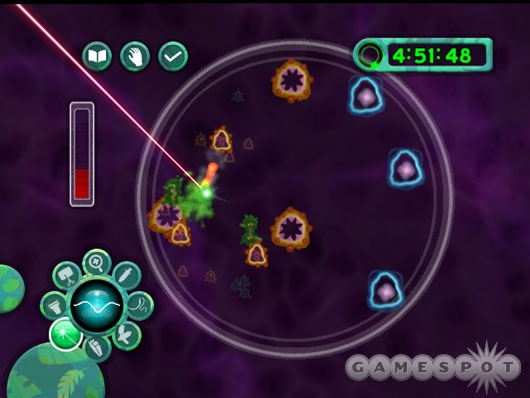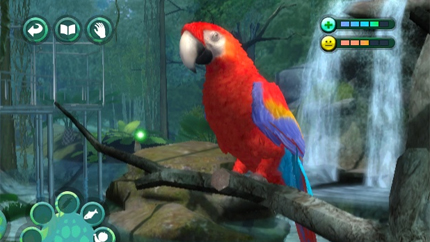Zoo Hospital for the Wii is a cuddly medical-themed puzzler in the style of Atlus' popular Trauma Center franchise. Unfortunately, it has none of the puzzle variation, intensity, or replayability of the Trauma Center games and presents very little challenge or depth. Its puzzles never increase in difficulty, and you're often forced to repeatedly endure the same operation type, compounding your sense of boredom. The sad reality of Zoo Hospital is that it boasts little more than cute animals.
The game opens with you receiving a call from Aunt Lucy, who operates a floundering zoo that's about to be bought out by a sinister businessman determined to replace it with a minigolf course. Your objective, as a licensed veterinarian fresh out of school, is to treat the zoo's animals as Lucy works to secure funding. The plot is rather uninteresting and disjointed, providing little backdrop for the operations you'll perform, though occasionally you'll treat an animal that advances the story.

The bulk of the gameplay is extremely straightforward and easy to master; a map of the zoo is displayed, conveniently marked with icons that let you know when an animal's health is in jeopardy. You merely click on an icon to send a distressed animal to the hospital wing, where you examine it by keeping the cursor inside the middle of a circle representing a magnifying glass. You're usually given five minutes to complete the appropriate operation, which may involve suturing wounds, laser-zapping viruses, applying antibacterial gel to rashes, or even pulling teeth. Each puzzle type requires simple movements of the Wii Remote, such as when you smack giant lice by making a brief, slashing motion, but sometimes, you'll have to shake the controller a little more forcibly to get it to register your movements. You'll encounter a similar control problem in a puzzle in which you guide a Tetris-like object through an animal's intestines because you'll find it difficult for the game to register that you've grabbed the object whenever it has been pushed too close to an obstruction.
Though the operation types are initially varied, you'll soon find yourself performing the same operation several times in a row or tackling the same infection with the same solution, which is irksome because the procedures don't evolve. The operation puzzles are very simplistic; they require almost no strategy and so quickly becoming tedious. For example, in the virus-zapping operation, the goal is to kill the infected cells before they damage the healthy ones, but the infected cells merely float around in no discernable pattern, encountering the healthy cells almost randomly.
Furthermore, most operations have very few stages and are purely external procedures, such as the syringe "operation" that requires you to do nothing more than inject an animal with a vaccine to successfully complete it. The game also fails to intensify with progression. The time element that is supposed to apply constant pressure to the gameplay is practically useless because many operations are completed in as little as 30 seconds; you shouldn't even breach the minute mark until you're more than halfway through. Even if you should run out of time or have an animal wake in the middle of an operation, there is no penalty for failure, which makes the gameplay even easier.
Aftercare opportunities are provided in an attempt to add depth, but they fail miserably. Following a 15-second operation, you may revisit your patient to observe it in a limited viewing field with a locked camera. You're sometimes asked to pet an animal's "sweet spot" until it rolls over in fits of ecstasy, effectively raising its happiness meter; however, it's difficult to do so given the game's frequent inability to correctly register the area of the animal you're petting. You can pet the creature's leg, where the sweet spot is located, but the game will register its leg as its stomach, which is irritating because you have to correctly pet some animals to proceed. Animals also have a health meter that you can raise by feeding them the appropriate food, but both gauges drain so slowly that they don't impact the gameplay, making animal monitoring a moot point.

Though Zoo Hospital looks better than it did on the DS, it retained several visual blemishes. Its greatest treat is its realistic, highly detailed portrayal of animals that all move fluidly in front of a floral backdrop; however, the local plants feature sharp, jaggy edges, and even the animals sport some very blurry fur. The operation screens have also been updated to feature more accurate body elements under the knife, which match the greater realism of the animals. With 47 species included, you're very likely to find a good representation of your childhood favorite, from its coloring pattern down to its usually accurate distress calls, though a few may have you scratching your head in disbelief. The music is sufficiently low-key during operations and upbeat after successful treatments, but only two primary songs are available, so don't expect any acoustic variety.
The game is surprisingly short; you should be able to complete all of its seven chapters in about five hours, though an epilogue that includes two baby animals and a famous mythological beast might bump you up to six hours. Torus Games did make an effort to increase replayability by adding a two-player cooperative mode to unlock, but the low amount of animal interaction, as well as operation challenge, prevents the feature from really being any fun or useful.
Zoo Hospital is a very bare-bones medical-themed puzzler that is short and dull, focusing on heavily repeated procedures, as well as simplistic operations that require almost no strategy at all. It's a pathetic attempt to capitalize on the Trauma Center formula, which needs more than cuddly creatures to succeed.